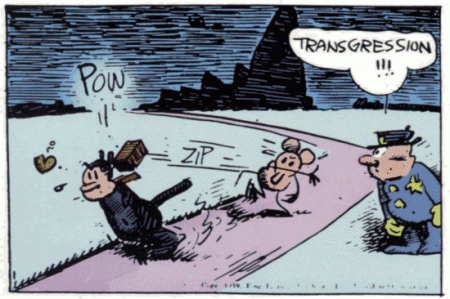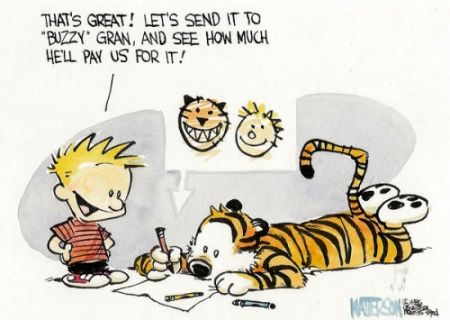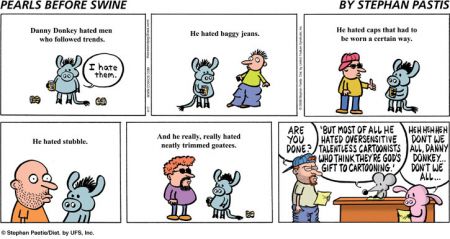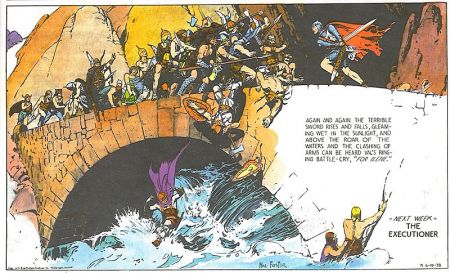Comics /
Comic Reviews /
Comic Strips
The Modern American Comic Strip Today
By Tom Spurgeon
August 17, 2008 - 15:25
As has frequently been the case for the wider art form of comics in this country's greater cultural landscape, the American comic strip has always enjoyed a love/hate relationship with its sponsors, newspapers. On the one hand, they're seen as a vital part of newspaper tradition and a big selling point for individual publications, and remain near the top of every poll concerning what readers read first and what they value most. On the other hand, most editors and writers can view them as frivolous entertainment 180 degrees removed from the newsgathering mission embraced. Even worse: at times objections to comic strip content can spill over into the already packed daily routine of an already harried newspaper staff. Comic strips may remind certain clients they are still a factor in the make-up of their daily product only when they're causing papers to lose rather than pick up readers. It's a dance of entertainment versus information, commerce versus civic responsibility, the frivolous versus the vital that will likely never end. It's also comic strips in America right now: undeniably still important, but not without its critics both inside and outside of the form.
 |
| Krazy Kat |
Two advancements in newspaper technology conspired to put comic strips into their unique present-day position. The development of printing processes that could provide a newspaper with full color and replicate complicated line work afforded this art form its power. When modern comic strips aficionado bemoan the size of today's newspaper strips they frequently forget that editors giving over entire pages to single features wasn't solely an aesthetic choice but a business matter to facilitate the greatest economic hammer blow from a limited in-house staff of illustrators and artists. Those editorial decision-makers maximized the comic strip form that was finding so many fans among both adults and children, the learned and the illiterates. The ability and business framework to syndicate comics, to bring the best and most popular offerings such as Sidney Smith's The Gumps to a number of readers rather than those in a specific region or the few likely to pick up a national newspaper in addition to their local, brought both fabulous wealth to the best cartoonists and I think helped guarantee an era where more voices and more properties would be pushed onto every page. Paper costs and changing economics would clinch an across-the-line shrinkage.
Since World War II the newspaper strip has been marked -- perhaps even primarily -- by a decline in the physical size of individual features. The sweeping panoramas of Krazy Kat begat the movie-ready canvases of a Terry and the Pirates spawned the simplified and precise linework of Peanuts and have brought us today to a iconographic approach to imagery perhaps best exemplified by Dilbert. Comic strips will never be as beautiful again, as they were during their ramp up concurrent with the Golden Age of Illustration; they will never produce as much wealth and prestige for as many individual features as they did during the heady days of widely read comics page superstars.
The newspaper comic strip industry today operates according to that skeleton set up decades ago, since festooned with modern flourishes of the kind that emphasize both the newspaper's general decline and its shift in emphasis away from surpassing, single-area content and more into vertical branding and portable licenses. Here's how it works. Although there is much less of an industry standard in terms of contracts and career paths as there was even a decade ago, most aspiring cartoonists still submit strip samples to one of a half-dozen remaining syndicates, big businesses that provide content to multiple newspaper clients. The major syndicates are King Features Syndicate, United Feature Syndicate, Universal Press Syndicate (together considered a Big Three by some, distinct from the rest in terms of reach and power), Washington Post Writers Group, Tribune Media and Creators. The comics industry has always held within its bosom a number of small syndicates and has even allowed for a few creators here and there to self-syndicate. That's an enormously tough road, and those sources seem to as a general rule matter less as the years progress. Today's print syndication landscape is as rigid as it's ever been.
 |
| Dilbert © Copyright United Feature Syndicate, Inc. |
A traditional comic strip contract may have the syndicate and the creator splitting all monies returned to the strip right down the middle, each receiving half. Newspapers traditionally pay for strips according to the newspaper's circulation numbers, making large newspapers clients that are more desirable in that way than smaller newspapers. In return for giving up what may seem like a draconian percentage of the profits, the creator gets access to a time-honored act of potential hit creation. The syndicate spends a six-figure sum creating marketing materials and generating advance publicity. A dedicated sales staff includes the new strip as part of its offerings to individual editors and group buyers. The syndicate may guarantee a minimum income to the creator despite the level of initial sales (Peanuts and Calvin and Hobbes were among hits to start with a modest client list), the idea being they relax the pressure on the creator to generate instant success while learning to deal with deadlines and the initial feedback they receive from readers and editors. They are able to offer creators a web site for promotion or, in many cases, outright on-line distribution.
Syndicates also provide the framework by which the strip goes from the artist to the client newspapers. King Features, for example, did this work in-house even through the majority of the 1990s before employing an outside vendor to provide this service to the artists with whom they work. Either the syndicate or the outside vendor provides basic editorial work like correcting typos, and in a strip's early years a creator may work closely with a syndicate editor until they know the ropes – what kinds of jokes are likely to lead to complaints, for example – and are producing on a regular basis the best strip possible. Syndicates also act as a parental figure in terms of enforcing deadlines. There is usually a monetary penalty involved for a strip being late, and syndicate editors tend to know various tricks for getting a strip back up to speed. I've heard of creators having it suggested to them that they write jokes to already existing panels that may be used to supplement new artwork or used instead of new artwork entirely. Syndicates have been known to step in with a week of re-runs for a catastrophically late feature, suggest an inker or a gag-writer that might help a struggling cartoonist or even terminate a contract because the creator can't hold up their end.
This may sound like a laborious set-up for what is essentially a few dozen comics on a page or two of your local newspaper, but it remains a successful one because a) it's profitable, sometimes immensely so, and b) it's efficient in that it rewards the most effective strips and exposes the ones with problems. A successful cartoonist in 1200 client newspapers does roughly the same amount of work as a cartoonist struggling with 40 clients. As a strip's fortunes improve, and the routines become familiar, most cartoonists begin to see the process of uploading strips and having them corrected or even colored as support mechanisms rather than a gauntlet designed to challenge their creativity. Bigger and bigger checks certainly help in this process. Conversely, it soon becomes clear that if a strip has only a dozen or so clients after several months of toiling in the marketplace – or that the cartoonist fails to hit deadlines or provide material that's up to snuff in terms of appropriateness and quality – that it may be a good idea for syndicate and creator to part ways.
 |
| Calvin and Hobbes © Copyright Bill Watterson |
Despite the shrinking number of newspapers, and the likelihood of years of modest returns before potentially ascending into a more comfortable middle class living, let alone the riches generated by a major hit, syndicates remained crushed by submissions from people convinced they have the next Luann, the next Zits, the next Pearls Before Swine. American Idol may have brought the idea of an open audition for stardom to the masses, but the American newspaper strip has offered the same opportunity week in and week out for decades now. The blind submission that leads to worldwide fortune is an American entrepreneurial fairy tale that continues to enchant thousands of wannabes.
The landscape for American newspaper comics has never been more volatile. The cartoonist Richard Thompson likes to say of his own modest client list, "I'm just glad to hear that there are 110 newspapers still out there." Comic strips felt the decline in the number of newspapers well before that freefall became this year's big publishing story. The loss of towns boasting of two or even three or more newspapers had a seismic effect on comic strips that benefited from dueling suitors for their services. In a town like Seattle or Chicago, it's not uncommon for a strip to be purchased by a newspaper simply so the other paper doesn't get it, whether or not the buyer has room in their pages at that particular time. A few dollars a month seems like a small price to pay to see if a feature may develop into the next Calvin and Hobbes before letting your cross-town rival have its way with it, and it can be a great boon to a creator to receive that money even if he's not appearing in the paper.
That bit of economic good fortune benefiting so many strips in their earliest days is almost entirely gone now. Newspaper strips have yet to determine their ultimate role in the move of publications on-line. While there have been a number of sales to newspapers for on-line use, and some success stories, there remains very little keeping a comic strip fan in Tucson from reading his favorite strips at a web site offered by the paper in San Jose. Additionally, the syndicates keep their own presences on-line, which some newspapers feel is direct competition with having those features on their sites. The proliferation of on-line comics, many of which appear in the same format as traditional newspaper strips, has changed the creative landscape by affording certain creators the opportunity to target a few dozen readers in every market as opposed to having to provide material that's at least amenable, or non-upsetting, to a wide variety of people. R. Stevens of Diesel Sweeties recently found through his own traditional syndication deal that he was more effectively able to reach readers with his acerbic work by going to them directly, with much greater efficiency and much more success in total when it came to making money.
 |
| © Copyright Stephan Pastis |
Because newspaper strips come from an era in which it was typical that multiple creators work on an offering during its lifetime, what's known as legacy strips gum up the works even further. Strips like Blondie or Prince Valiant far removed from their original creators still hold thousands of places in client newspapers. With no guarantee that a new strip will prove as popular, or that it's their new strip and not a rival's that will take an older strip's place, no syndicate is willing to sacrifice a still-profitable offering even if some feel that having so many older properties on the comics page is creatively stifling. Many believe that having Mark Schultz and Gary Gianni on Prince Valiant is a lost opportunity on the level of NBC casting a rising stand-up comic in a new version of Sgt. Bilko rather than developing a vehicle around his specific talents.
As is the case with many traditional arts industries, the newspaper strip continues to attract those who see a successful career possible in its long-established framework and those to whom the prestige and history of the professional has a specific appeal. The newspaper comic experienced a bit of revival in the 1980s by a trio of features that turned a lot of conventional wisdom on its head: The Far Side, with its obtuse humor and frequently grotesque moments; Calvin and Hobbes, with its lovely art, memorable characters and its creator's demands for specific space requirements; and Bloom County, with its loose and rambling style and outright ease with modern cultural and political attitudes.
The best creators today have built on that recent artistic legacy with a number of smaller hits just as potent as any ever done on the comics page: among them Patrick McDonnell's beautifully drawn and gag-light Mutts, Richard Thompson's astonishingly light on its feet Cul De Sac, Mark Tatulli's pantomime hit Lio and Stephan Pastis' frequently absurd and caustic. Pearls Before Swine. Some of the industry's most successful veterans, such as Scott Adams of Dilbert and Garry Trudeau of Doonesbury, are the most aggressive when it comes to managing book deals and exploiting the on-line world. All creators work in the shadow of Charles Schulz's legacy, which allows for rigorous licensing and cross-media opportunities as a way to enhance the core offering.
 |
| Prince Valiant |
Lynn Johnston's Brett Favre-like will-she-or-won't-she retirement drama over the last two years ends August 31st when she brings current storylines on her long-running For Better or For Worse to a close. The surprising attention to comic strips' grand lady taking a final bow, and the vehement objection of many comics fans to final plot developments in her strip regarding the characters Liz and Anthony, has reminded us all just how deep the affection lies for even the most traditional strips still out there. The comic-strip permutation of our national preoccupation with snark and sarcasm that has developed in places like the Comics Curmudgeon feels as vital and funny as those sites paying attention to the latest celebrity faux-pas, with the added bonus that goofing on Gil Thorp feels less soul-destroying than watching some drug-addled, talent-light young woman struggle to leave a club at 2:30 in the morning. The secret to the comic strip's continuing vitality is that it really is still your parents' comics page, and it's also yours, and it will be both yours and theirs and someone else's tomorrow. In a folded over newspaper or on a flickering computer screen, so many mornings wouldn't be the same without it.
Last Updated: January 17, 2025 - 08:20




